The Intel Core Ultra 7 155H Review: Meteor Lake Marks A Fresh Start To Mobile CPUs
by Gavin Bonshor on April 11, 2024 8:30 AM EST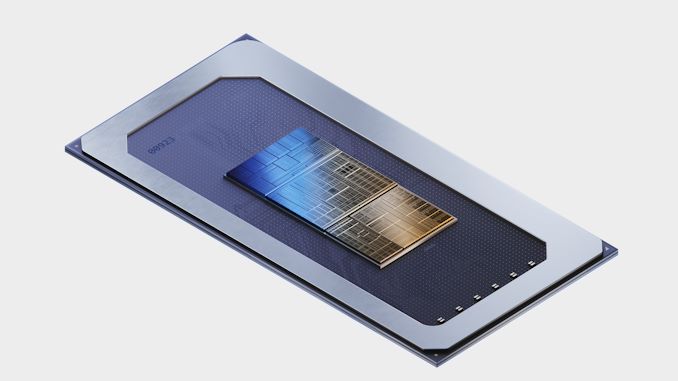
One of the most significant events of last six months in mobile computing has been Intel and the launch of their disaggregated Meteor Lake SoC architecture. Meteor Lake, along with the new Core and Core Ultra product brands, heralds the dawn of Intel's first chiplet architecture for mass-market mobile devices, courtesy of the Intel 4 node and Foveros packaging technology.
In December last year, Intel unveiled their premier Meteor lake-based Core Ultra H series, with five SKUs ranging from three with 16 CPU cores, and another two SKUs with 14 cores. Since then, many vendors and manufacturers have launched notebooks capitalizing on Intel's latest multi-tiled Meteor Lake SoC architecture as the heart of power and performance, driving their latest models into 2024.
Today, we will take our first deep dive into Meteor Lake's performance with our review of Intel's Core Ultra 7 155H processor. This is an upper-tier (but not flagship) Core Ultra SKU, featuring all 16(!) of Meteor Lake's CPU cores, and is aimed at mainstream performance laptops. With a base TDP of 28 Watts – and a turbo TDP as high as 115 Watts – the 155H is intended to go in everything from desktop replacement laptops to powerful ultrabooks.
Which brings us to our review sample for this launch: the ASUS Zenbook 14 OLED (UX3405MA), a thin-and-light notebook design that has been sampled by Intel as their launch vehicle for Core Ultra. Much of the attention on this notebook is (understandably) focused on how the Intel Core Ultra 7 155H with its 6P+8E+2LP CPU core configuration and 8 Arc Xe integrated graphics cores performs. As the first brand-new consumer chip architecture out of Intel since Alder Lake in 2021, Meteor Lake is an important milestone release for the company on multiple levels.
Still, the ASUS Zenbook 14 OLED UX3405MA is more than just a vessel for Intel's new CPU, and ASUS has equipped it plenty of features within its sleek Ponder Blue colored shell to make it very interesting. Included is a 14" 2.8K (2880 x 1800) touchscreen OLED panel with a 120 Hz refresh rate, 32 GB of LPDDR5X memory (soldered), and a 1 TB NVMe M.2 SSD for storage, all with the aim of producing a competitive and compelling highly-portable laptop.
Intel Meteor Lake SoC Architecture: A Quick Recap
Before we dive into our review of the ASUS Zenbook 14 OLED (UX3405MA) with Intel's Core Ultra 7 155H mobile processor, we will quickly recap what's new with Intel's Meteor Lake SoC. Below is a list of our comprehensive and detailed commentary on Intel's Meteor Lake SoC:
- Intel Unveils Meteor Lake Architecture: Intel 4 Heralds the Disaggregated Future of Mobile CPUs
- Intel Releases Core Ultra H and U-Series Processors: Meteor Lake Brings AI and Arc to Ultra Thin Notebooks
- Intel Meteor Lake SoC is NOT Coming to Desktops: Well, Not Technically
In September last year, Intel outlined the technical specifications for Meteor Lake as part of their Innovation 2023 event, showcasing their intention to depart from manufacturing conventional monolithic processors and instead opt for a multi-tiled design. This approach utilizes Intel's Foveros 3D packaging and combines different tiles from different process nodes to create a chiplet-based CPU. As Intel has highlighted multiple times, Meteor Lake is an exclusively mobile architecture designed for laptops and notebooks.
The Meteor Lake SoC is inherently composed of five interconnected tiles – compute, graphics, SoC, I/O, and base – each incorporating new advancements, such as the compute tile with Redwood Cove Performance (P) cores and Crestmont Efficiency (E) cores. The Compute tile is special because it is built using the latest Intel 4 node, designed to improve power and efficiency over previous generations. A notable addition to the compute tile and the performance and efficiency core structure is the inclusion of two energy-efficient LP-E cores embedded within the SoC tile, which are designed for low-intensity tasks.
The SoC tile is Meteor Lake's plexus hub and, along with the I/O tile, is made using TSMC's N6 node. This new chiplet-based design signifies a major architectural shift for Intel. Using 3D chip stacking overcomes the power and latency limitations of traditional 2D chiplet layouts, and the modular design enhances power management and allows for independent tile operation, improving both performance and energy efficiency. It also offers flexibility as a tiled architecture, which allows Intel to use different silicon processes for each tile.
Also present within the SoC tile are two Neural Compute Engines: Intel's implementation of an NPU designed for generative AI and optimized for these types of workloads. Intel calls this 'Intel AI Boost' and is primarily designed to handle tasks such as image processing and light generative AI workloads by taking them off the CPU/GPU processing them more efficiently in the task-specific NPU silicon. Similar in concept to AMD's Ryzen AI NPU – though Intel's NPU is much more flexible and programmable – these NPUs somewhat limited in what they can do and what they can influence in relation to performance in inferencing workloads. While you might think of them as comprehensive AI workhorses by the name, they are designed to improve AI features within Windows and applications such as Adobe Premiere Pro.
Lastly, there's the GPU tile built on TSMC's N5 node, and upgrades integrated graphics seen on previous generations to the Arc Xe-LPG core. The Arc Xe-LPG core is related to Intel's discrete Xe-HPG GPU architecture, bringing many (but not all) of its features to the domain of integrated GPUs. It includes 16 Vector Engines with robust capabilities and a dedicated FP64 unit, differing from the previous generation's architecture. All-told, this is a DirectX 12 Ultimate (feature level 12_2) class design, putting it at par with the latest GPU architectures when it comes to graphics features. It also separates things with Intel implementing the Xe Media Engine into the SoC tile, which supports various codecs and is optimized for power-efficient encoding and decoding.
| Intel Core Ultra H-Series Processors: Meteor Lake (Intel 4) | ||||||||
| AnandTech | Cores (P+E+LP/T) |
P-Core Turbo Freq |
E-Core Turbo Freq |
GPU | GPU Freq | L3 Cache (MB) |
Base TDP | Turbo TDP |
| Ultra 9 | ||||||||
| Core Ultra 9 185H | 6+8+2/22 | 5100 | 3800 | Arc Xe (8) | 2350 | 24 | 45 W | 115 W |
| Ultra 7 | ||||||||
| Core Ultra 7 165H | 6+8+2/22 | 5000 | 3800 | Arc Xe (8) |
2300 | 24 | 28 W | 64/115 W |
| Core Ultra 7 155H | 6+8+2/22 | 4800 | 3800 | Arc Xe (8) | 2250 | 24 | 28 W | 64/115 W |
| Ultra 5 | ||||||||
| Core Ultra 5 135H | 4+8+2/18 | 4600 | 3600 | Arc Xe (8) |
2200 | 18 | 28 W | 64/115 W |
| Core Ultra 5 125H | 4+8+2/18 | 4500 | 3600 | Arc Xe (7) | 2200 | 18 | 28 W | 64/115 W |
Before we take a look at the ASUS Zenbook 14 OLED (UX3405MA), which is powered by the Intel Core Ultra 7 155H processor, Intel also has four other SKUs available for users to choose from. This is relevant as the Zenbook 14 OLED is available with the top SKU, the Core Ultra 9 185H, and the entry-level Core Ultra 5 125H. The Core Ultra 9 185H, the Core Ultra 7 165H, and the Core Ultra 7 155H, which is the chip SKU we are testing, all have the same core configuration with 6P+8E+2LP/22T, with 24 MB of Intel's Smart L3 cache and a maximum turbo TDP rating of 115 W. The only differences between these three models are the P-Core turbo core frequency and the Arc Xe graphics core frequency. The Core Ultra 9 185H also has a higher base TDP of 45 W, while the rest of the stack has a base TDP rating of 28 W.
Intel's latest Meteor Lake SoC architecture is primarily designed for mobile platforms such as notebooks and laptops, with a key emphasis on prolonging battery life through power efficiency. Unlike the previous Raptor Lake (13th/14th Gen Core series) architecture Meteor Lake supersedes, Meteor Lake doesn't technically replace the 14/13th Gen HX series mobile processors, as these are desktop processors that have been repurposed for mobile. Meteor Lake effectively slots in ahead of the Intel 13th Gen Core P and U series mobile processors, such as the Core i7 1370P and Core i7 1365U.
As Meteor Lake is indeed an SoC architecture and the first of Intel's for mobile using their disaggregated tiled architecture, it signals the move away from the more traditional monolithic design. Not only does 3D chip stacking with their Foveros 3D packaging technology, but it also allows Intel to overcome limitations involved with 2D chip layouts. Another benefit to switching to a disaggregated architecture is Intel can package their chips using multiple tiles built on different nodes, which is essentially like complicated silicon-based Lego.
The other thing Meteor Lake brings with it is new branding, with Intel dropping the famous 'i' from the Core naming structure, so processors from Meteor Lake onwards from their consumer range will simply be the Core 7, Core 5, and Core 3. Intel also adds an Ultra tier, including the Core Ultra 9, Core Ultra 7, and Core Ultra 5 series. It's the end of an era since 2008 when the first Core i series processor launched, with the Intel Core i9-14900KS is likely the last consumer processor to feature the 'i'.
ASUS Zenbook 14 OLED (UX3405MA): 14" Ultrabook
Moving onto the bread and butter of today's review and the delivery vehicle that brings us Intel's Meteor Lake SoC is the ASUS Zenbook 14 OLED (UX3405MA) 14" ultrabook. The Zenbook series itself is one of ASUS's longest-standing notebook series, with the first iterations originally launching all the way back in October 2011. The first model, the ASUS Zenbook UX21E, featured an 11.6'' 1366 x 768 screen with Intel's archaic but popular Sandy Bridge architecture. Fast forward to now, and we have the very much evolved Zenbook series, with the Zenbook 14 OLED UX3405MA coming with a 14" touchscreen that features a 120 Hz refresh and 2880 x 1800 OLED panel.
With many different varieties of notebooks, including the fabled gaming notebooks with mobile-based processors and discrete graphics cards to the top-tier desktop replacement laptops featuring desktop-level performance, the ASUS Zenbook 14 OLED is neither of these. Instead, the Zenbook 14 OLED series caters more to users looking for a sleek and lightweight, very portable ultrabook that is a jack of all trades but a master of none. That's not to the detriment of the Zenbook 14 OLED, as with a thin and sleek design comes the trade-off of needing to run with a lower power envelope as cooling is more limited than the thicker designed notebooks.
Some of the primary features and selling points of the ASUS Zenbook 14 OLED (UX3405MA) include the processor of choice, which is the Intel Core Ultra 7 155H for this sample. It has six performance (Redwood Cove) cores and eight Efficiency (Crestmont) cores, with two new Low Power Island cores embedded within the processor's SoC tile, which is designed to handle low-intensity tasks in the background. As Meteor Lake is more of a system on a chip (SoC) than a typical processor, the Core 7 Ultra 155H comes with Intel's latest graphics architecture embedded onto the chip, which Intel calls Arc Xe LPG. This includes eight Arc Xe graphics cores with a maximum dynamic frequency of up to 2.25 GHz and powers the vibrant yet eloquent 2.8K display on the Zenbook 14 OLED.
Touching more on the display within the ASUS Zenbook 14 OLED, it uses what ASUS calls their Lumina OLED display, and the 14" panel has a variable refresh rate, so users can select between opting for 60 Hz or 120 Hz. While this isn't technically a feature for gaming that many may associate with high refresh rates, it's more for smoother video than playing the latest games; the Zenbook 14 OLED is an ultrabook and not a dedicated gaming notebook, but that doesn't mean users can't dip their toes in with Intel's Xe LPG graphics integrated into the machine.
| Intel Core Ultra 7 155H (Meteor Lake) Review Notebooks | |||||||
| ASUS Zenbook 14 OLED As Reviewed |
MSI Prestige 13 AI Evo A1MG | ||||||
| Processor | Intel Core Ultra 7 155H 6P+8E / 22 T 4,8 GHz P-Core Turbo 3.8 GHz E-Core Turbo 28 W Base TDP 64/115 W Turbo TDP |
||||||
| Memory | 32 GB LPDDR5X - 2x16 (Soldered) | ||||||
| GPU | Intel Arc Xe LPG 8 x Xe Graphics Cores 2.25 GHz Boost 0.3 GHz Base |
||||||
| Display | 14" 2880 x 1800 16:10 OLED Touchscreen Panel 60/120 Hz Refresh 0.2 ms Response Up to 400 nits/500nits with HDR 100% DCI-P3 Gamut |
13.3" 2800x1800 16:10 OLED Panel 60 Hz Refresh 5 ms Response Up to 400 nits 100% DCI-P3 Gamut |
|||||
| Storage | 1 TB PCIe 4.0 x4 NVMe | 1 TB PCIe 4.0 x4 NVMe | |||||
| Networking | Intel AX211 Wi-Fi 6E Bluetooth 5.3 |
Intel Killer BE1750 Wi-Fi 7 Bluetooth 5.4 |
|||||
| Audio | Harmon Kardon Linear Speakers Built-in Array Microphone 3.5 mm Audio Jack |
2 x Speakers (2 W) | |||||
| Battery | 75 Wh 65 W Watt AC Type-C Adapter |
||||||
| I/O | 2 x USB-C/Thunderbolt 4 (Display/PD) 1 x USB 3.2 G1 Type-A 1 x HDMI 2.1 output (TMDS) 1 x 3.5mm Combo Audio Jack |
2 x USB 3.2 G2 Type-C 1 x USB 3.2 G1 Type-A 1 x Micro SD Card Reader 1 x HDMI 2.1 output 1 x 3.55 mm Combo Audio Jack |
|||||
| Dimensions | 12.30 x 8.67 x 0.59 inches (312.4 x 220.1 x 14.9 mm) |
11.77 x 8.27 x 0.67 inches (298.9 x 210 x 17 mm) |
|||||
| Weight | 1.28 kg / 2.82 lb | 0.98 kg / 2.18 lb | |||||
| Camera | 1080p /w Privacy Shutter + Windows Hello IR | 1080p /w Privacy Shutter + Windows Hello IR | |||||
| Color | Ponder Blue | Black | |||||
| Pricing | $1299 (As configured) | $1299 (As configured) | |||||
And to make sure we're not just looking at Meteor Lake's performance in a single design, for this review we're also testing the MSI Prestige 13 AI Evo A1MG, which features the same Core Ultra 7 155H processor. In contrast to the Zenbook 14 OLED, MSI's notebook has a smaller overall footprint, with a 13-inch 2880 x 1800 OLED panel, with a 60 Hz refresh rate, slower 5 ms response time, but it does come equipped with 32 GB of LPDDR5x memory, and a 1 TB NVMe storage drive. Aside from the striking similarities in the platform of both of these Intel 'ultrabooks,' they are very similar in internal specifications, giving us an additional data point to compare. It's also worth noting that the smaller profile means cooling could be a little more limited than the ASUS. With the same $1299 MSRP for both models, it offers a direct comparison for the money with both models featuring similar specifications and the same Intel Core Ultra 7 155H Meteor Lake processor at the heart of things,
Pivoting back to the Zenbook, it has a sleek and nice aluminum finish, which looks good with the Ponder Blue color used. Looking at some of the features, ASUS includes dual Thunderbolt 4-cable USB Type-C ports, which support both external display and power delivery, as the Zenbook 14 OLED relies on Type-C charging. ASUS includes a 65 W AC Type-C adapter in the box and an ASUS stylus designed to be used with the 14" 2880 x 1800 OLED touch screen.
For storage, ASUS includes a 1 TB PCIe 4.0 x2 SSD, which is the Western Digitial WD560 within our Zenbook 14 OLED sample, while memory is a trickier one to decipher. ASUS includes 2 x 16 GB of LPDDR5X memory, but not even the latest version of CPU-Z can read the DRAM frequency from this model. We also know from ASUS that the DRAM is soldered into the board, so users can't upgrade this, and the only thing users can upgrade internally (if they can get in the chassis) is the storage drive.
Other features include a full HD (1080p) webcam with a privacy shutter and Windows Hello (IR) support. At the same time, premium Harmon Kardon linear speakers provide audio with a built-in array microphone. Users can use the included 3.5 mm audio combo jack if they wish to plug in a headset that isn't USB Type-A.
The ASUS Zenbook 14 OLED UM3405MA represents a quintessential thin-and-light notebook that conforms to Intel's EVO specifications. With the Intel Core Ultra 7 155H combined with the integrated Arc Xe LPG graphics cores, it looks to provide ample and solid performance to the market. It's a lightweight, ultra-thin notebook weighing just 1.28 KG and just 14.9 mm thick. On the next page, we'll take a closer look at the style and design of the ASUS Zenbook 14 OLED, and we'll see how the performance compares to AMD's Ryzen 9 7940HS with the Radeon 780M integrated graphics within the Razer Blade 14. Can Intel's mid-range Meteor Lake SoC via the Core Ultra 7 155H compete with the completion? Let's find out.



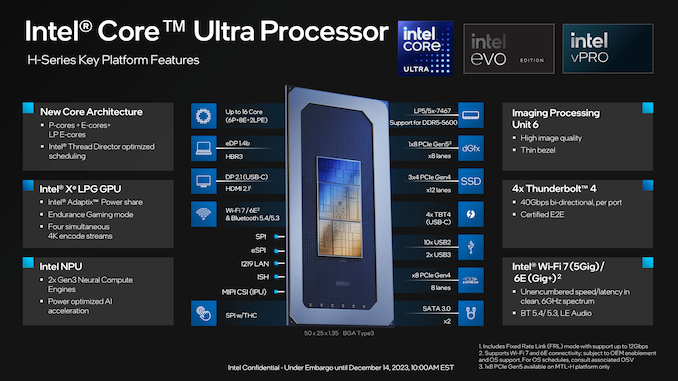
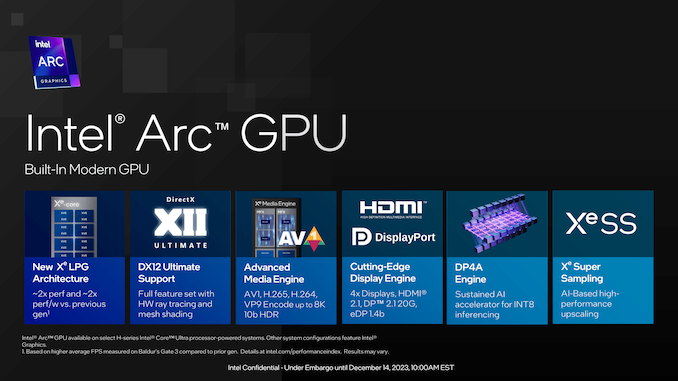
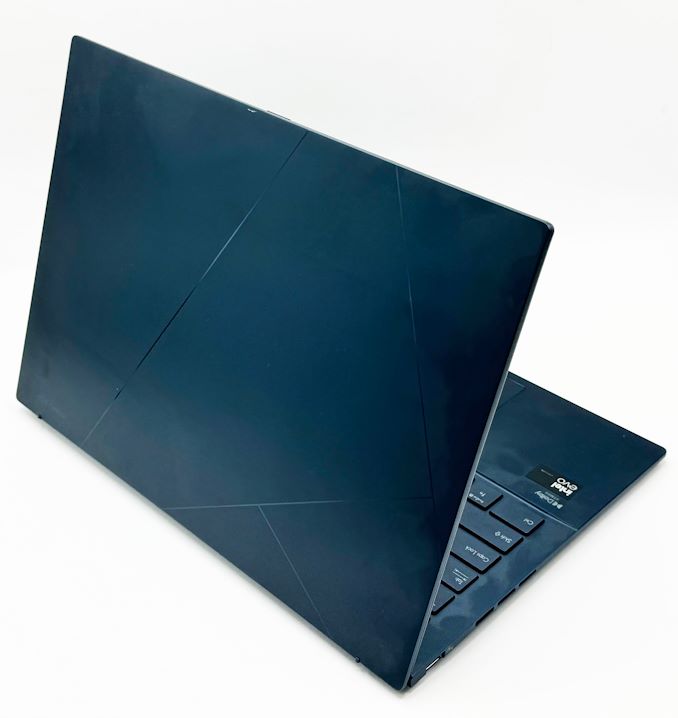
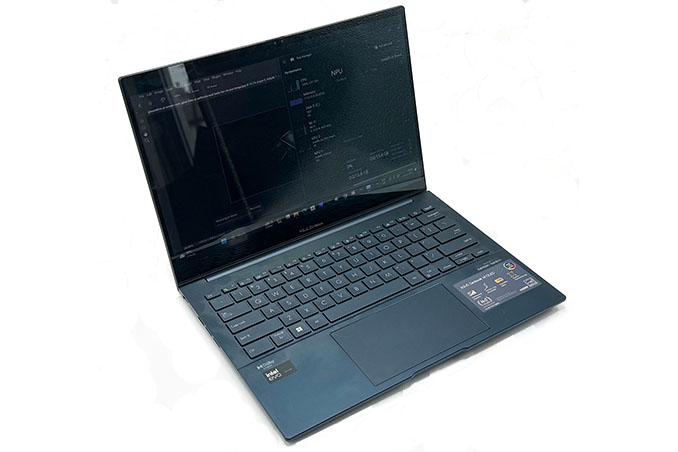
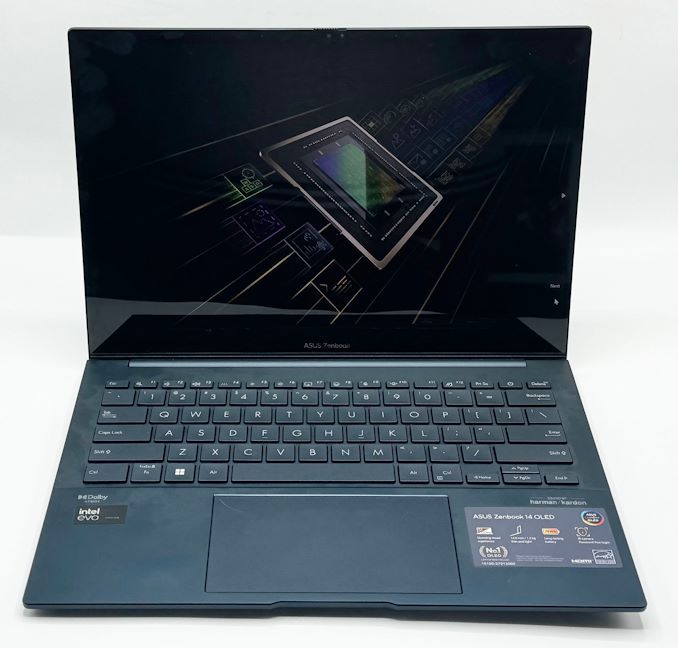
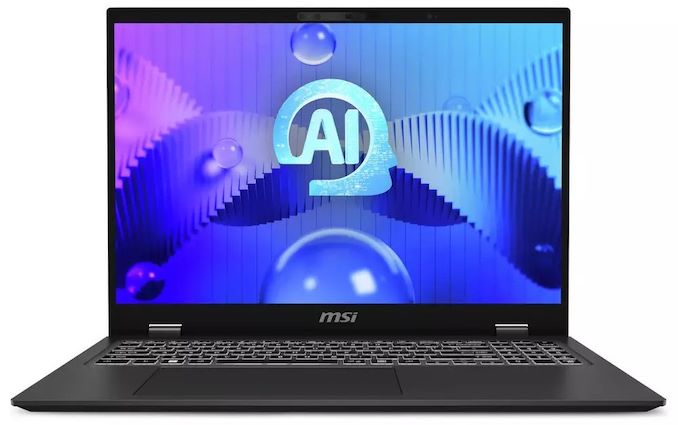








69 Comments
View All Comments
Dante Verizon - Thursday, April 11, 2024 - link
Too strange... in the spec2017 test that represents Blender MeteorLake wins but in the real Blender test it loses? GreatDante Verizon - Thursday, April 11, 2024 - link
The iGPU performance of desktop APUs is also abnormally low.Gavin Bonshor - Friday, April 12, 2024 - link
Could you please elaborate? Did another publication's results land higher? Did they run JEDEC memory settings?ballsystemlord - Thursday, April 11, 2024 - link
That near 50% increase in DRAM access latency coupled with the higher thermal limitations is probably what's holding the 115H back.Ryan Smith - Thursday, April 11, 2024 - link
Keep in mind that they're different workloads with different versions of Blender. The version in SPEC2017 is from 7 years ago, which was the Blender 2.7 era.mode_13h - Monday, April 15, 2024 - link
spec2017 is using an old version of Blender that's frozen in time. That's needed to make all spec2017 results comparable with each other.In the individual Rendering benchmarks, Gavin used a reasonably current version of Blender (3.6 is a LTS release from June 27, 2023), probably also built with a different compiler.
Hulk - Thursday, April 11, 2024 - link
"AMD Arc" in GPU specs?Gavin Bonshor - Friday, April 12, 2024 - link
Yeah, that was a really weird one. It has since been corrected.Fozzie - Thursday, April 11, 2024 - link
Why is the text seemingly out of line with the actual results? Repeatedly it is describing wins for the U7 155H that don't seem to be backed up in the actual benchmarks. For example:"As we can see from our rendering results, the Intel Core Ultra 7 155H is very competitive in single-threaded performance and is ahead of AMD's Zen 4 mobile Phoenix-based Ryzen 9 7940HS."
Actually, the graphs don't show a single instance of the Ultra 7155H besting the Ryzen 9 7940HS in ALL of the preceding graphs.
"Looking at performance in our web and office-based testing, in the UL Procyon Office-based tests using Microsoft Office, the Core Ultra 7 155H is actually outperforming the AMD Ryzen 9 7940HS, which is a good win in itself."
How is 6,792 greater than 7,482? How is 6,978 higher than 7,162?
Did the benchmarks get updated after the text was written? Did someone write the summary text and not pay attention to "Higher is better" vs "Lower is better"?
phoenix_rizzen - Thursday, April 11, 2024 - link
The text describing the Spec tests are also incorrect."Even though the Core Ultra 7 155H is technically an SoC, it remains competitive in the SPECint2017 section of our single-thread testing against the Ryzen 9 7940HS. The AMD chip performs better in two of the tests (525.x264_r and 548.exchange2_r); on the whole, Intel is competitive."
Except the graph shows the AMD system beating the Intel system in 7 tests and only losing by a small margin in 3 of them. The AMD system even beats the Intel desktop system in 4 tests and ties it in 1.
"In the second section of our single-threaded testing, we again see a very competitive showing in SPECfp2017 between the Intel Core Ultra 7 155H and the AMD Ryzen 9 7940HS. The only test we see a major gain for the Ryzen 9 7940HS is in the 503.bwaves_r test, which is a computational fluid dynamics (CFD) simulation."
Except the AMD system wins in 4 tests, essentially ties in 5 tests, and only loses in 2. It even beat the desktop system in 3 tests.
The text is nowhere near consistent with the graphs.